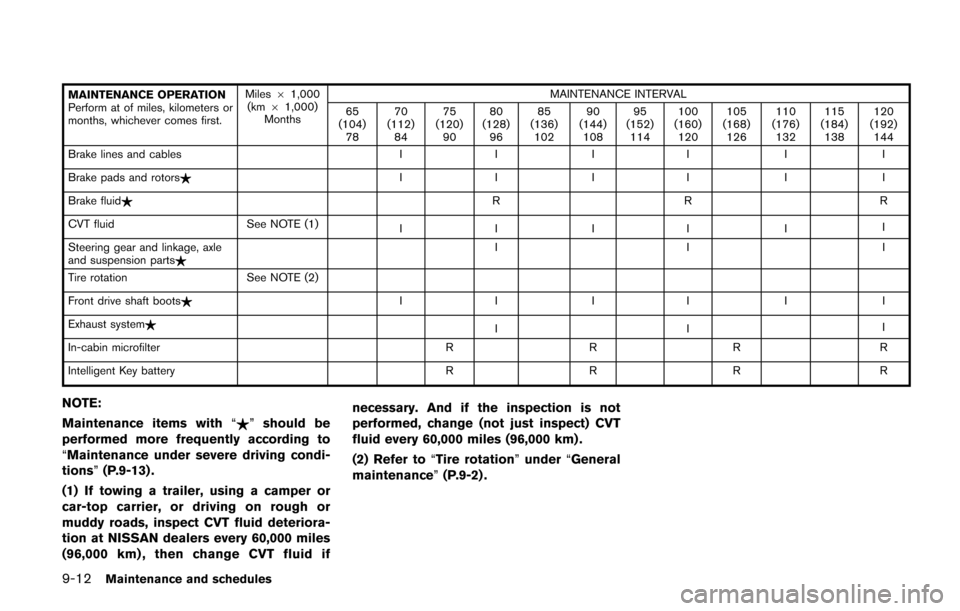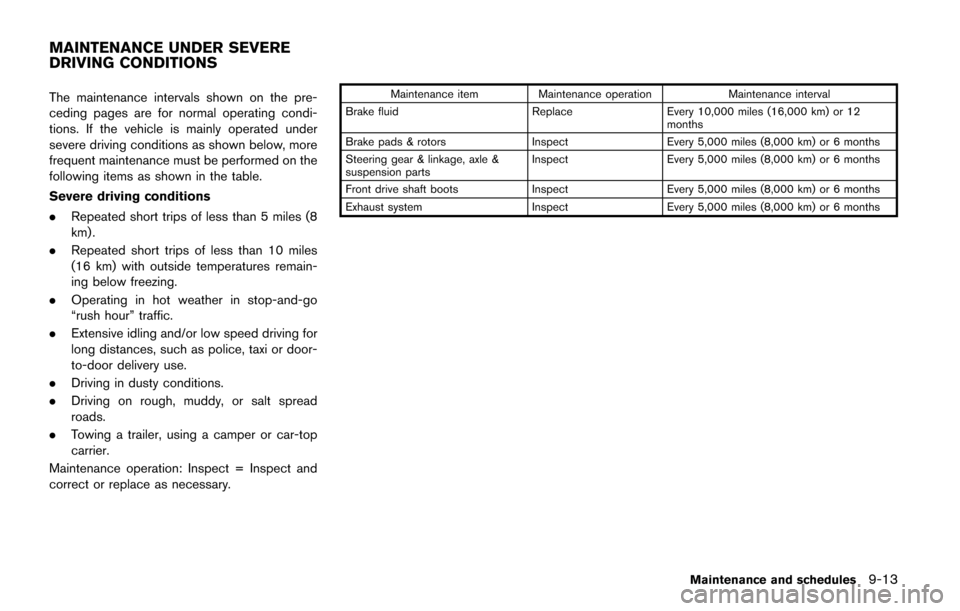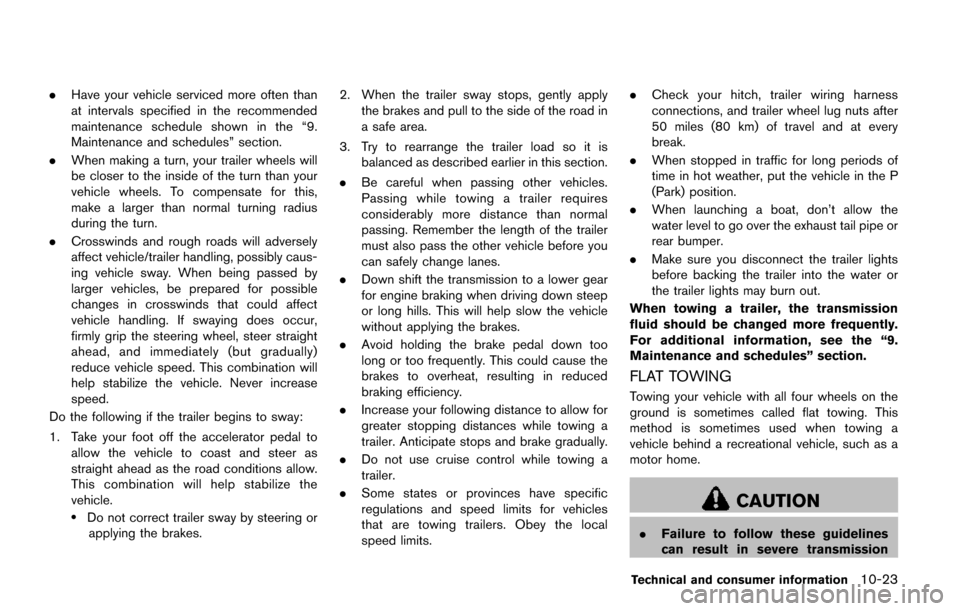Page 477 of 520
9-10Maintenance and schedules
maintenance items and intervals are re-
quired.
Page 478 of 520
CHASSIS AND BODY MAINTENANCE
Abbreviations: I = Inspect and correct or replace as necessary, R = Replace
MAINTENANCE OPERATION
Perform at of miles, kilometers or
months, whichever comes first.Miles
61,000
(km 61,000)
Months MAINTENANCE INTERVAL
5
(8) 6 10
(16) 12 15
(24) 18 20
(32) 24 25
(40) 30 30
(48) 36 35
(56) 42 40
(64) 48 45
(72) 54 50
(80) 60 55
(88) 66 60
(96) 72
Brake lines and cables II II I I
Brake pads and rotors$ II I I I I
Brake fluid$ RR R
CVT fluid See NOTE (1)
II I I I I
Steering gear and linkage, axle
and suspension parts$ II I
Tire rotation See NOTE (2)
Front drive shaft boots $ II I I I I
Exhaust system$ II I
In-cabin microfilter RR R R
Intelligent Key battery RR R R
Maintenance and schedules9-11
Page 479 of 520

9-12Maintenance and schedules
MAINTENANCE OPERATION
Perform at of miles, kilometers or
months, whichever comes first.Miles
61,000
(km 61,000)
Months MAINTENANCE INTERVAL
65
(104) 78 70
(112) 84 75
(120) 90 80
(128) 96 85
(136) 102 90
(144) 108 95
(152) 114 100
(160) 120 105
(168) 126 110
(176) 132 115
(184) 138 120
(192) 144
Brake lines and cables II II I I
Brake pads and rotors$ II II I I
Brake fluid$ RR R
CVT fluid See NOTE (1)
II II I I
Steering gear and linkage, axle
and suspension parts$ II I
Tire rotation See NOTE (2)
Front drive shaft boots$ II II I I
Exhaust system$ III
In-cabin microfilter RRR R
Intelligent Key battery RRR R
NOTE:
Maintenance items with “$”should be
performed more frequently according to
“Maintenance under severe driving condi-
tions” (P.9-13) .
(1) If towing a trailer, using a camper or
car-top carrier, or driving on rough or
muddy roads, inspect CVT fluid deteriora-
tion at NISSAN dealers every 60,000 miles
(96,000 km) , then change CVT fluid if necessary. And if the inspection is not
performed, change (not just inspect) CVT
fluid every 60,000 miles (96,000 km) .
(2) Refer to
“Tire rotation” under“General
maintenance” (P.9-2) .
Page 480 of 520

The maintenance intervals shown on the pre-
ceding pages are for normal operating condi-
tions. If the vehicle is mainly operated under
severe driving conditions as shown below, more
frequent maintenance must be performed on the
following items as shown in the table.
Severe driving conditions
.Repeated short trips of less than 5 miles (8
km) .
. Repeated short trips of less than 10 miles
(16 km) with outside temperatures remain-
ing below freezing.
. Operating in hot weather in stop-and-go
“rush hour” traffic.
. Extensive idling and/or low speed driving for
long distances, such as police, taxi or door-
to-door delivery use.
. Driving in dusty conditions.
. Driving on rough, muddy, or salt spread
roads.
. Towing a trailer, using a camper or car-top
carrier.
Maintenance operation: Inspect = Inspect and
correct or replace as necessary.Maintenance item Maintenance operation Maintenance interval
Brake fluid ReplaceEvery 10,000 miles (16,000 km) or 12
months
Brake pads & rotors InspectEvery 5,000 miles (8,000 km) or 6 months
Steering gear & linkage, axle &
suspension parts Inspect
Every 5,000 miles (8,000 km) or 6 months
Front drive shaft boots InspectEvery 5,000 miles (8,000 km) or 6 months
Exhaust system InspectEvery 5,000 miles (8,000 km) or 6 months
Maintenance and schedules9-13
MAINTENANCE UNDER SEVERE
DRIVING CONDITIONS
Page 481 of 520
9-14Maintenance and schedules
5,000 Miles (8,000 km) or 6 Months
Dealer Name:
Date:
Mileage:
Dealer
Stamp:10,000 Miles (16,000 km) or 12 Months
Dealer Name:
Date:
Mileage:
Dealer
Stamp:15,000 Miles (24,000 km) or 18 Months
Dealer Name:
Date:
Mileage:
Dealer
Stamp:
20,000 Miles (32,000 km) or 24 Months
Dealer Name:
Date:
Mileage:
Dealer
Stamp: 25,000 Miles (40,000 km) or 30 Months
Dealer Name:
Date:
Mileage:
Dealer
Stamp:30,000 Miles (48,000 km) or 36 Months
Dealer Name:
Date:
Mileage:
Dealer
Stamp:
35,000 Miles (56,000 km) or 42 Months
Dealer Name:
Date:
Mileage:
Dealer
Stamp: 40,000 Miles (64,000 km) or 48 Months
Dealer Name:
Date:
Mileage:
Dealer
Stamp:45,000 Miles (72,000 km) or 54 Months
Dealer Name:
Date:
Mileage:
Dealer
Stamp:
MAINTENANCE LOG
Page 482 of 520
50,000 Miles (80,000 km) or 60 Months
Dealer Name:
Date:
Mileage:
Dealer
Stamp:55,000 Miles (88,000 km) or 66 Months
Dealer Name:
Date:
Mileage:
Dealer
Stamp:60,000 Miles (96,000 km) or 72 Months
Dealer Name:
Date:
Mileage:
Dealer
Stamp:
65,000 Miles (104,000 km) or 78 Months
Dealer Name:
Date:
Mileage:
Dealer
Stamp: 70,000 Miles (112,000 km) or 84 Months
Dealer Name:
Date:
Mileage:
Dealer
Stamp:75,000 Miles (120,000 km) or 90 Months
Dealer Name:
Date:
Mileage:
Dealer
Stamp:
80,000 Miles (128,000 km) or 96 Months
Dealer Name:
Date:
Mileage:
Dealer
Stamp: 85,000 Miles (136,000 km) or 102 Months
Dealer Name:
Date:
Mileage:
Dealer
Stamp:90,000 Miles (144,000 km) or 108 Months
Dealer Name:
Date:
Mileage:
Dealer
Stamp:
Maintenance and schedules9-15
Page 483 of 520
9-16Maintenance and schedules
95,000 Miles (152,000 km) or 114 Months
Dealer Name:
Date:
Mileage:
Dealer
Stamp:100,000 Miles (160,000 km) or 120 Months
Dealer Name:
Date:
Mileage:
Dealer
Stamp:105,000 Miles (168,000 km) or 126 Months
Dealer Name:
Date:
Mileage:
Dealer
Stamp:
110,000 Miles (176,000 km) or 132 Months
Dealer Name:
Date:
Mileage:
Dealer
Stamp: 115,000 Miles (184,000 km) or 138 Months
Dealer Name:
Date:
Mileage:
Dealer
Stamp:120,000 Miles (192,000 km) or 144 Months
Dealer Name:
Date:
Mileage:
Dealer
Stamp:
Page 506 of 520

.Have your vehicle serviced more often than
at intervals specified in the recommended
maintenance schedule shown in the “9.
Maintenance and schedules” section.
. When making a turn, your trailer wheels will
be closer to the inside of the turn than your
vehicle wheels. To compensate for this,
make a larger than normal turning radius
during the turn.
. Crosswinds and rough roads will adversely
affect vehicle/trailer handling, possibly caus-
ing vehicle sway. When being passed by
larger vehicles, be prepared for possible
changes in crosswinds that could affect
vehicle handling. If swaying does occur,
firmly grip the steering wheel, steer straight
ahead, and immediately (but gradually)
reduce vehicle speed. This combination will
help stabilize the vehicle. Never increase
speed.
Do the following if the trailer begins to sway:
1. Take your foot off the accelerator pedal to allow the vehicle to coast and steer as
straight ahead as the road conditions allow.
This combination will help stabilize the
vehicle.
.Do not correct trailer sway by steering orapplying the brakes. 2. When the trailer sway stops, gently apply
the brakes and pull to the side of the road in
a safe area.
3. Try to rearrange the trailer load so it is balanced as described earlier in this section.
. Be careful when passing other vehicles.
Passing while towing a trailer requires
considerably more distance than normal
passing. Remember the length of the trailer
must also pass the other vehicle before you
can safely change lanes.
. Down shift the transmission to a lower gear
for engine braking when driving down steep
or long hills. This will help slow the vehicle
without applying the brakes.
. Avoid holding the brake pedal down too
long or too frequently. This could cause the
brakes to overheat, resulting in reduced
braking efficiency.
. Increase your following distance to allow for
greater stopping distances while towing a
trailer. Anticipate stops and brake gradually.
. Do not use cruise control while towing a
trailer.
. Some states or provinces have specific
regulations and speed limits for vehicles
that are towing trailers. Obey the local
speed limits. .
Check your hitch, trailer wiring harness
connections, and trailer wheel lug nuts after
50 miles (80 km) of travel and at every
break.
. When stopped in traffic for long periods of
time in hot weather, put the vehicle in the P
(Park) position.
. When launching a boat, don’t allow the
water level to go over the exhaust tail pipe or
rear bumper.
. Make sure you disconnect the trailer lights
before backing the trailer into the water or
the trailer lights may burn out.
When towing a trailer, the transmission
fluid should be changed more frequently.
For additional information, see the “9.
Maintenance and schedules” section.
FLAT TOWING
Towing your vehicle with all four wheels on the
ground is sometimes called flat towing. This
method is sometimes used when towing a
vehicle behind a recreational vehicle, such as a
motor home.
CAUTION
. Failure to follow these guidelines
can result in severe transmission
Technical and consumer information10-23